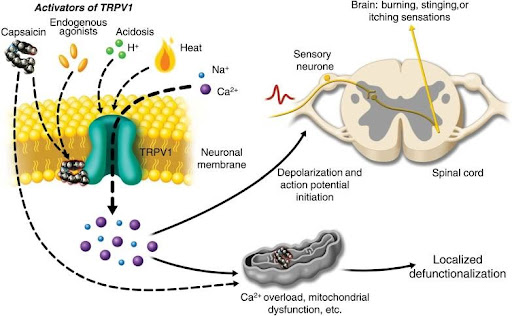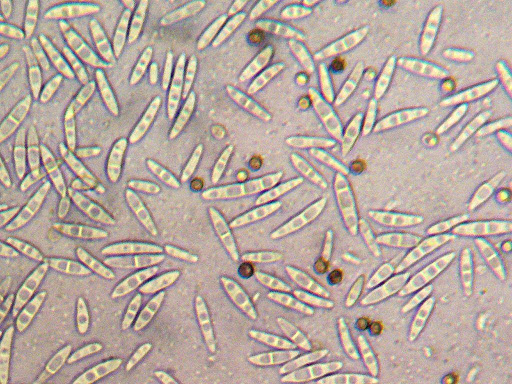You look down at the ramen in front of you. The aroma is enticing, smelling of cinnamon, turmeric, and chilies. As the sauce enters your mouth, your eyes start to water, your nose runs, and your whole mouth is on fire, but you love it. Why?

People around the world use chili peppers to enhance flavor and add spiciness. Our culture is a big reason why we use spice. As omnivores, trying new foods can be scary, so cultures tend to favor seasoning patterns in their dishes, such as garlic in Italian cuisine or turmeric in Indian dishes. Our own food preferences and customs influence the way we taste, leading some people to enjoy spicy foods. Recent research has also proposed that personality and gender norms influence our liking of spicy foods. Specifically, this research concluded that men are motivated to eat spicy foods by external factors, like kudos from others and the machismo associated with eating spicy foods. Women are more motivated by the taste itself, even though other studies have reported an increased risk of gastrointestinal issues due to spicy food consumption in women.
But what makes a chili spicy?
Capsaicin is a compound found in chilis that provides spiciness. In your body, capsaicin binds to receptors on your nerves that send pain signals to the brain. These receptors, TRPV1 channels, are also activated by extreme heat, which is why spiciness feels similar to a burn.

Your body has two different kinds of pain: pain from something harmful, like a hammer or spiciness, or nerve pain, like arthritis or diabetic neuropathy. Capsaicin can sometimes be used as a cream to block nerve pain. This is likely because capsaicin interferes with your body's ability to signal to your brain about nerve pain. Even though there is an initial burn, after a while your nerves are prevented from firing and you no longer feel the neuropathy.
This year, the Nobel Prize in Physiology or Medicine was awarded jointly to David Julius and Ardem Patapoutian for discovering receptors important for temperature and touch, including the TRPV1 receptor. These scientists' discoveries aided in our understanding of sensation, including touch, heat, cold, and pain. Understanding how the TRPV1 channel works is crucial to understand pain signaling, but we still don't know a lot about capsaicin itself.

What is the reason for capsaicin in chilis? Why does it even exist?
Surprisingly, not all creatures can detect the spicy flavor. Humans and other mammals can, but birds cannot. Birds have the same TRPV1 receptor, but it does not respond to capsaicin. This allows birds to eat chilies and disperse the seeds. This is beneficial to the chili plants which need help furthering their species. Additionally, many animals chew the seeds and render them useless, so capsaicin production is advantageous if it discourages these creatures from destroying good seeds. However, scientists are beginning to think that deterring mammals is not the main reason for capsaicin production in peppers.
In areas where there is variation in chili capsaicin production, scientists have found a negative correlation with infection by the fungus Fusarium semitectum. This means that spicier chilis have lower infection rates and chilis with less capsaicin suffer more from fungal infection. This fungus causes pepper seeds to lose their vitality, and eventually kills the plant. Capsaicin is a deterrent to the insects that allow the fungus entry into the pepper. But this isn't universal. In moist climates, capsaicin production is beneficial because the infection risk is high. But in low moisture environments, capsaicin-producing peppers are at a disadvantage – they produce fewer seeds. This environmental phenomenon has led to a wide variety in chili capsaicin production, from bell peppers all the way to the ghost pepper.

So how did we come to like the heat?
Most of the chilis we eat today come from one type of domesticated chili in what is present-day Mexico over 5000 years ago. Through colonization and trade, chilis were adopted into Asian and European cuisines. In northern Europe, researchers found evidence of local spices and herbs being added to food around the time of early animal domestication.
Since the domestication of chilis and their distribution across the world, scientific advances have made it possible to selectively breed chilis for certain traits, like fungal resistance, flavor, and productivity. This has created the wide variety of commercially available chilis we have today. So the next time you eat a bowl of ramen, know it's capsaicin you have to thank for that tasty spice.
About the Author
Kendall Clay is a fourth-year Neuroscience PhD candidate in the Roberts-Galbraith lab. She studies genes responsible for the regeneration of dopaminergic neurons in worms called planarians. Her main interests include genetics, disease, and regeneration. Outside of the lab, Kendall enjoys singing, embroidering, and hanging out with her cats, Baby and Sporty. You can contact Kendall at Kendall.clay@uga.edu.
- Kendall Clayhttps://athensscienceobserver.com/author/kendall-clay/
- Kendall Clayhttps://athensscienceobserver.com/author/kendall-clay/March 17, 2022
- Kendall Clayhttps://athensscienceobserver.com/author/kendall-clay/








